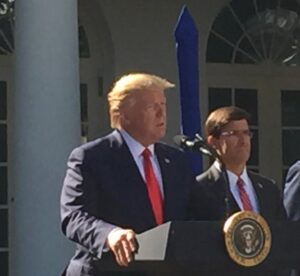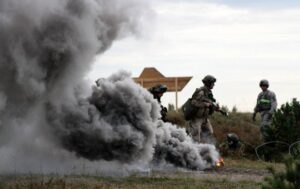
Vehicles await to be loaded on ships to Europe in support of DEFENDER-Europe 20.
WASHINGTON: This morning, the Secretary of Defense, Vice Chairman of the Joint Chiefs, and head of US forces in Europe painstakingly explained to reporters at the Pentagon that pulling 12,000 US troops out of Germany was a smart strategic move, unrelated to President Trump’s anger at German defense spending. An hour later, the president blew it all up.
“We don’t want to be the suckers anymore,” the president said at the White House Wednesday morning. “So we’re reducing the force because they’re not paying their bills. It’s very simple, they’re delinquent.”
Trump, as he has done for years, conflated the pledge by NATO nations to spend two percent of their GDP on national defense with payments to the alliance itself. Germany, despite being the wealthiest nation in Europe, continues to fall well below that mark.

Trump and Sec. Esper on a more harmonious occasion.
During the Pentagon briefing this morning, Defense Secretary Mark Esper repeatedly made the case that moving the troops back to the US, or to Belgium and Italy, is a strategic decision that will benefit the US and its NATO allies. Despite his claim that some movement will start within “weeks,” it was clear that the bulk of the planning is yet to be done.
Esper said that the total cost of the movements would be in the single digit billions, and movement was on the verge of beginning. Then the Vice Chairman of the Joint Chiefs, Gen. John Hyten quickly walked that back:
“The secretary said single digit billions, but those are rough estimates,” Hyten said. “What we have right now is really a concept ― a concept that we’ve shared with our allies, shared with the Congress, and we shared inside the department fairly widely. We now have to turn it into plans. As you turn into plans, we have a very structured process involving the Joint Staff, the office of the secretary, and the combatant commands and the services, to make sure we understand what those are, then we’ll lay in the costs.”
Hyten’s comments served as a brake on what appeared to be an urgent push to move the troops, indicating that there are no firm plans to do anything other than talk with European allies and align complex budget lines and a massive logistical push. His comments suggest any final decisions are weeks or months away, and are wrapped up with consultations with allies and building out new infrastructure to house US forces, both deployed and rotational.
Lots of Flak
Denunciations came quickly from former top commanders and leading Republicans.
In a rare rebuke of the president, GOP Sen. Ben Sasse decried the withdrawal in blunt language.
“The President’s lack of strategic understanding of this issue increases our response time and hinders the important deterrent work our servicemen and women are doing,” he said. “We should be leading our allies against China and Russia, not abandoning them. Withdrawal is weak.”
Retired Supreme Allied Commander at NATO, Adm. James Stavridis, tweeted this morning that “Abruptly pulling 12,500 troops out of Germany (to put half of them in countries who spend LESS on defense) doesn’t make sense financially, hurts NATO solidarity overall, and is a gift to Putin.”
Doug Lute, former US Ambassador to NATO and retired 3-star general, tweeted that the move “makes zero strategic sense when judged against the stated objectives,” of deterring China and Russia.
Longtime Trump critic Sen. Mitt Romney called the plan “a grave error” and “a slap in the face at a friend and ally when we should instead be drawing closer in our mutual commitment to deter Russian and Chinese aggression,” Romney said in a statement. “The move may temporarily play well in domestic politics, but its consequences will be lasting and harmful to American interests.“
However, some Eastern European allies are eager to host US troops coming out of Germany.
Overall, the plan would bring 6,400 service members home and reposition 5,600 elsewhere in Europe, including possibly moving troops to the Baltic nations and Poland. The move will leave 24,000 troops in Germany.

Latvian soldiers train with US Airborne troops.
Earlier this month, Latvian officials told me they were eager to strike a deal with Washington to bring some of those troops to their country, but said talks were in the very early stages. Any movement of more troops to Poland is also contingent on the signing of a long-awaited security pact with the government in Warsaw. There were expectations that the deal would be signed with Policy President Andrzej Duda visited Washington last month, but negotiations continue.
The rough outline presented by the military leaders this morning revealed that about 2,000 troops from the US military’s European Command headquarters in Stuttgart, Germany, will relocate to Mons, Belgium. The Africa Command headquarters, also in Germany, is also likely to move to Spain or Italy.
Also, 4,500 members of the Second Cavalry Regiment in Germany will return to the US, and then begin rotations in the Black Sea region. Elsewhere, the 2,500 airmen scheduled to deploy to Germany from the U.K. will remain in the U.K., while an F-16 squadron will be sent to Italy.
Italy spends approximately 1.2% of its GDP on defense, while Belgium spends even less, .93%. Those countries are both less than the German 1.38%, making the president’s comments even more puzzling.
Sullivan: Defense industry ‘still underestimating’ global need for munitions
National Security Advisor Jake Sullivan said that there are “no plans” for another Ukraine supplemental at this point.


























